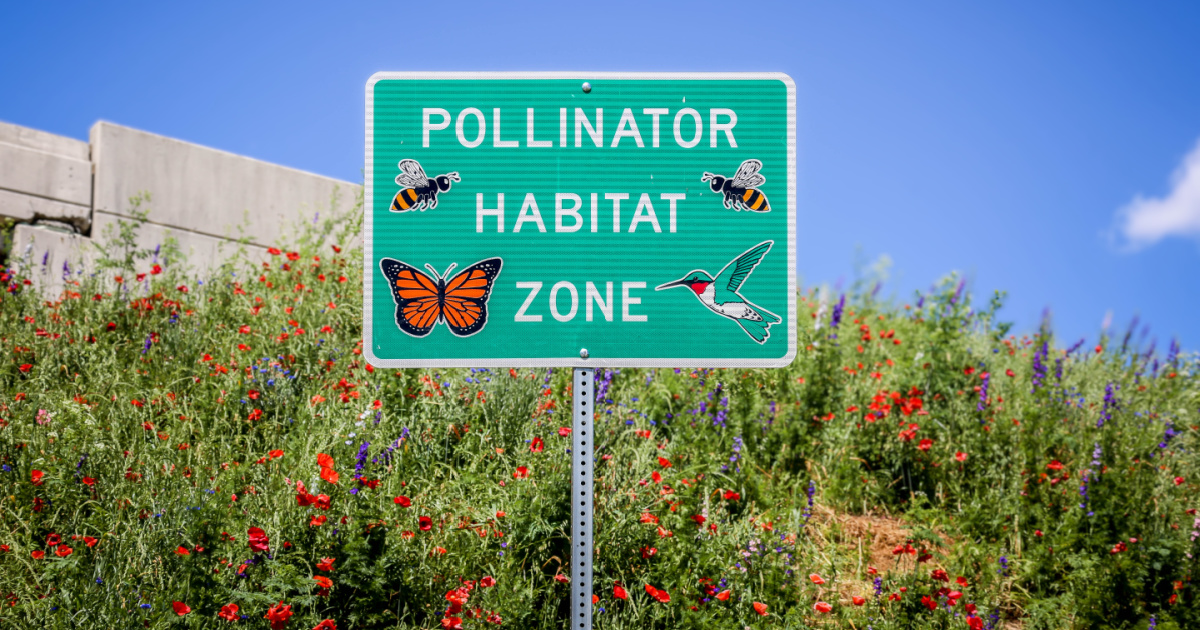Pollinators Make a Beeline for Roadside Wildflower Plots
Posted on Jun 29, 2022
Kentucky Transportation Cabinet’s Pollinator Habitat Zones provide a buffet for beneficial bees, butterflies, and other insects.
While traveling Kentucky’s interstates this summer, keep your eyes peeled for bright bursts of native blooms along the way. Plots of Kentucky wildflowers like milkweed, coneflower, and goldenrod create a sea of color all season long… and for a good purpose.
The Kentucky Transportation Cabinet (KYTC) currently manages 100 of these roadside plots, blanketing approximately 200 acres across the state with mostly native plants, flowers, and grasses. These showy areas do more than provide beauty for passing commuters; they also provide declining pollinator populations with much-needed nutrients and habitat.
“Pollinators are really critical for many agricultural crops and honey production in our state,” said Mike Smith, Roadside Environment State Administrator for KYTC. “Their survival is also essential to the survival of many native plants, birds, and animals.”
More than 80 percent of the world’s flowering plants need a pollinator to reproduce, according to the U.S. Department of Agriculture (USDA). This creates a distinct connection between pollinators and our food: Much of what we eat comes from flowering crops. In fact, the USDA estimates that one out of every three bites of our food, including fruits, vegetables, chocolate, coffee, nuts, and spices is created with the help of pollinators.
“I’m really pleased with the commitment that the Transportation Cabinet has made towards this effort, and I think it beautifies the Commonwealth—although that is a secondary benefit,” said Tammy Potter, Kentucky State Apiarist. “The primary benefit is that it provides more nutrition to our pollinators.”
This program was born in 2015 following a memorandum from then-President Obama that directed state and federal agencies to develop pollinator protection plans for lands they managed, as well as encourage private landowners to adopt best practices on their land. State departments of transportation, like KYTC, were encouraged to establish pollinator-friendly vegetation on highway rights-of-ways for the benefit of honey bees, native bees, butterflies, and other pollinator species.
Potter worked in tandem with KYTC to launch this initiative. The first Pollinator Habitat Zone seedlings popped up in 2015, with blooms beginning to show in 2016.
“To me, it’s just a marvelous improvement because otherwise, we’re devoting taxpayer funds to do nothing but mow,” Potter said. “With these public rights-of-way, we’re talking about a lot of acreage that could be put toward beneficial purposes, especially given that our insects are in decline.”
Potter said that shortages of natural nutrients, specifically nectar and pollen, have contributed to declining pollinator populations.
“There is serious concern among beekeepers that there isn’t enough nutrition—natural nectar and pollen provided by flowers—to meet a colony’s needs,” she said.
KYTC’s Pollinator Habitat Zone program aims to provide natural nutrients for all pollinators, including, various insects, bees, and butterflies, especially the monarch butterfly, a species threatened with extinction. The host plant for monarchs is milkweed, which KYTC additionally plants in butterfly way stations at welcome centers, rest areas, and other sites. While honey bees are critical to the agriculture industry (providing $27 billion to the agriculture economy annually), various other pollinators such as monarchs, bats, and native solitary bees are also extremely important (contributing $6 billion annually), according to Potter.
To select the most beneficial species of native flora, KYTC collaborates with several experts, including Roundstone Native Seed Co., University of Kentucky, Kentucky Department of Fish and Wildlife, U.S. Fish and Wildlife Service, Kentucky Department of Agriculture, National Resources Conservation Service, Office of Kentucky Nature Preserves, Monarch Watch, and Kentucky garden clubs. Each plot contains 10 to 30 species mostly native plant species to provide diverse nutritional offerings for an array of pollinators.
“This program has benefited greatly from the knowledge and decades of experience in quality native seed production, seeding services, and native plant maintenance of Roundstone Native Seed Co., our contractor,” Smith said. “This partnership has allowed us to expand the program to all of our 12 Highway Districts.”
By 2022, KYTC aims to grow the Pollinator Habitat Zones by at least 50 acres.
“Kentucky must do its part to save pollinators,” Smith said.
For more information on KYTC’s thriving pollinator and environmental protection initiatives, visit: transportation.ky.gov/EnvironmentalAnalysis/Pages/Ecology-and-Permitting.aspx.
Comments